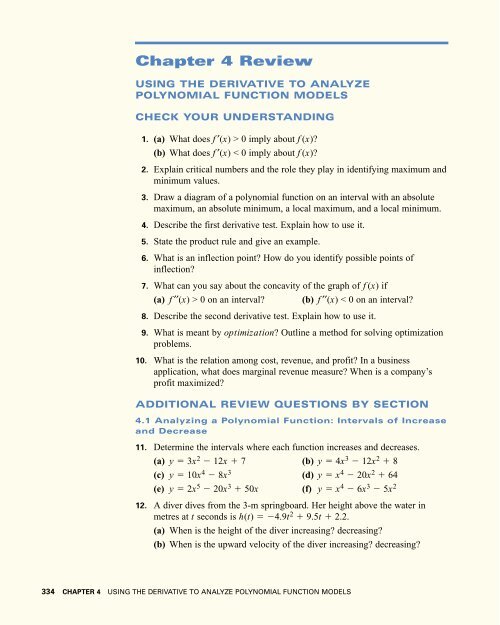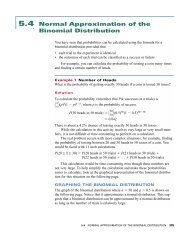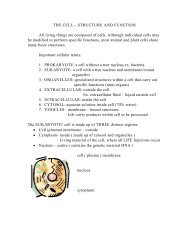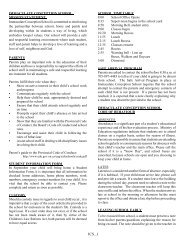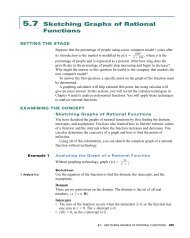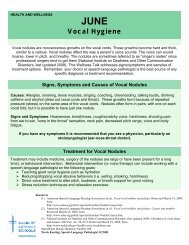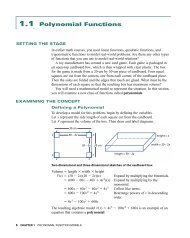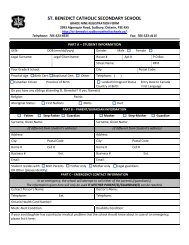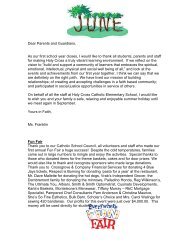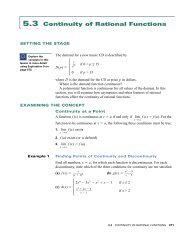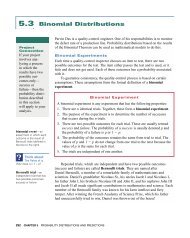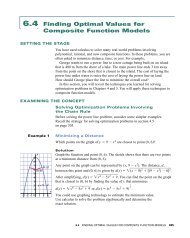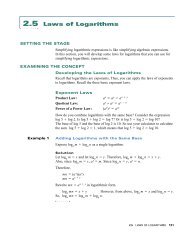Pg 334
Pg 334
Pg 334
You also want an ePaper? Increase the reach of your titles
YUMPU automatically turns print PDFs into web optimized ePapers that Google loves.
Chapter 4 Review<br />
USING THE DERIVATIVE TO ANALYZE<br />
POLYNOMIAL FUNCTION MODELS<br />
CHECK YOUR UNDERSTANDING<br />
1. (a) What does f ′(x) > 0 imply about f (x)?<br />
(b) What does f ′(x) < 0 imply about f (x)?<br />
2. Explain critical numbers and the role they play in identifying maximum and<br />
minimum values.<br />
3. Draw a diagram of a polynomial function on an interval with an absolute<br />
maximum, an absolute minimum, a local maximum, and a local minimum.<br />
4. Describe the first derivative test. Explain how to use it.<br />
5. State the product rule and give an example.<br />
6. What is an inflection point? How do you identify possible points of<br />
inflection?<br />
7. What can you say about the concavity of the graph of f (x) if<br />
(a) f ′′(x) > 0 on an interval? (b) f ′′(x) < 0 on an interval?<br />
8. Describe the second derivative test. Explain how to use it.<br />
9. What is meant by optimization? Outline a method for solving optimization<br />
problems.<br />
10. What is the relation among cost, revenue, and profit? In a business<br />
application, what does marginal revenue measure? When is a company’s<br />
profit maximized?<br />
ADDITIONAL REVIEW QUESTIONS BY SECTION<br />
4.1 Analyzing a Polynomial Function: Intervals of Increase<br />
and Decrease<br />
11. Determine the intervals where each function increases and decreases.<br />
(a) y 3x 2 12x 7 (b) y 4x 3 12x 2 8<br />
(c) y 10x 4 8x 3 (d) y x 4 20x 2 64<br />
(e) y 2x 5 20x 3 50x (f) y x 4 6x 3 5x 2<br />
12. A diver dives from the 3-m springboard. Her height above the water in<br />
metres at t seconds is h(t) 4.9t 2 9.5t 2.2.<br />
(a) When is the height of the diver increasing? decreasing?<br />
(b) When is the upward velocity of the diver increasing? decreasing?<br />
<strong>334</strong> CHAPTER 4 USING THE DERIVATIVE TO ANALYZE POLYNOMIAL FUNCTION MODELS
13. The concentration, C, of a drug injected into the bloodstream t hours<br />
t<br />
after injection can be modelled by C(t) 4 2t 2 . Determine when the<br />
concentration of the drug is increasing and when it is decreasing.<br />
4.2 Maximum and Minimum Values of a Polynomial<br />
Function<br />
14. Find the absolute maximum and minimum values.<br />
(a) f (x) x 2 2x 6, 1 ≤ x ≤ 7<br />
(b) f (x) x 3 x 2 , 3 ≤ x ≤ 3<br />
(c) f (x) x 3 12x 2, 5 ≤ x ≤ 5<br />
(d) f (x) 3x 5 5x 3 , 2 ≤ x ≤ 4<br />
(e) f (x) 2x 3 3x 2 12x, 2 ≤ x ≤ 2<br />
(f) f (x) x 4 18x 2 , 4 ≤ x ≤ 4<br />
15. After a football is punted, its height, h, in metres above the ground at<br />
t seconds can be modelled by h(t) 4.9t 2 21t 0.45.<br />
(a) Determine the restricted domain of this model.<br />
(b) When does the ball reach its maximum height?<br />
(c) What is the ball’s maximum height?<br />
16. Determine the equation of the line tangent to f (x) 4x 3 12x 2 96x<br />
with the smallest slope on the interval 4 ≤ x ≤ 2.<br />
4.3 The First Derivative Test<br />
17. Graph y f ′(x) for the given function.<br />
10<br />
8<br />
6<br />
4<br />
2<br />
–4 –3 –2 –1 0<br />
–2<br />
–4<br />
–6<br />
–8<br />
–10<br />
y<br />
1 2 3 4<br />
y = f(x)<br />
x<br />
18. For each function f (x),<br />
i. find the critical numbers<br />
ii. determine where the function increases and decreases<br />
iii. determine whether each critical number is at a maximum, a minimum,<br />
or neither<br />
iv. use all the information to sketch the graph<br />
CHAPTER 4 REVIEW 335
(a) f (x) x 2 7x 18<br />
(b) f (x) 2x 3 9x 2 3<br />
(c) f (x) 2x 4 4x 2 2<br />
(d) f (x) x 5 5x<br />
(e) f (x) x 4 8x 3 18x 2 6<br />
(f) f (x) 3x 5 5x 4<br />
19. For groups of 60 or more, a charter bus company computes total revenue<br />
using R(x) x[10 0.1(x 60)], x ≥ 60. What size of group will<br />
maximize revenue?<br />
4.4 Finding Some Shortcuts — The Product Rule<br />
20. Find the derivative using the product rule.<br />
(a) f (x) (4x 2 9x)(3x 2 5)<br />
(b) f (t) (3t 2 7t 8)(4t 1)<br />
(c) f (x) (5x 2 3x) 2<br />
(d) f (x) 2x 4 (3x 2 3x)(2x 2 3x)<br />
(e) f (x) 4x 3 (4x 2x 2 )<br />
(f) f (z) z(2z 3 5z)<br />
21. Find the equation of the tangent to y (5x 2 9x 2)(x 2 2x 3) at<br />
(1, 48).<br />
22. For f (x) (5x 3)(x 2 x 1), determine the critical numbers, the<br />
intervals of increase or decrease, and the extrema. Use this information to<br />
graph the function.<br />
4.5 Finding Optimal Values for Polynomial Function<br />
Models<br />
23. A park ranger has 600 m of floating rope. She is going to enclose a<br />
rectangular swimming area, using the beach as one border of the area.<br />
Find the maximum area that can be enclosed and the corresponding<br />
dimensions.<br />
24. A rectangular box is to be constructed from two different materials. The box<br />
will have a square base and open top. The material for the bottom costs<br />
$4.25/m 2 . The material for the sides costs $2.50/m 2 . Find the dimensions of<br />
the box with the largest volume if the budget is $500 for the material.<br />
25. The landlord of a 50-unit apartment building is planning to increase the<br />
rent. Currently, residents pay $850/month and all units are occupied.<br />
A real estate agency advises that every $100 increase in rent will result in<br />
10 vacant units. What rent should the landlord charge to maximize revenue?<br />
336 CHAPTER 4 USING THE DERIVATIVE TO ANALYZE POLYNOMIAL FUNCTION MODELS
4.6 Rates of Change in Business and Economics<br />
26. A soft-drink company estimates that the cost, C, in dollars of producing x<br />
litres of product per day is C(x) 0.0005x 2 4x 4000.<br />
(a) Find the marginal cost if 5000 L is produced.<br />
(b) Determine the daily production level to minimize the average cost.<br />
27. A publisher can sell x thousand copies of a monthly sports magazine if it<br />
x<br />
sells for p 5 dollars. The monthly cost of publishing, C, can be<br />
10 0<br />
modelled by C(x) 8000 200x 0.05x 2 .<br />
(a) Determine the revenue function.<br />
(b) Determine the profit function.<br />
(c) Calculate the profit on the sale of 20 000 magazines.<br />
(d) Calculate the marginal profit on the sale of 30 000 magazines.<br />
(e) Calculate the maximum profit and the sales required to realize the<br />
profit.<br />
28. The cost to produce one high-definition TV is $750. The manufacturer<br />
charges $1800 per unit for orders of 50 or less. The price will be reduced<br />
by $15 per unit for larger orders. Determine the size of order that<br />
(a) maximizes revenue<br />
(b) maximizes profit<br />
4.7 Sketching Graphs of Polynomial Functions: Concavity<br />
29. Determine the intervals of concavity and the points of inflection.<br />
(a) y x 3 3x 2 45x (b) y 2x 3 9x 2 108x 200<br />
(c) y x 4 54x 2 250 (d) y x 4 12x 2<br />
30. Determine the intervals where each function increases or decreases.<br />
Also determine where the graph of the function is concave up or<br />
down, the maximum and minimum points, and the points of inflection.<br />
Use the information to graph each function.<br />
(a) y 2x 2 12x 8 (b) y 2x 3 3x 2 12x 3<br />
(c) y 2x 3 3x 2 36x<br />
(d) y x 4 32x<br />
(e) y x 3 x 2 5x 3 (f) y 3x 5 5x 3 60x<br />
31. Use the second derivative test to show that f (x) x 3 2x 2 has a local<br />
maximum at the origin.<br />
REVIEW QUESTIONS BY ACHIEVEMENT<br />
CHART CATEGORIES<br />
Knowledge and Understanding<br />
32. (a) Determine the intervals where f (x) x 4 4x 3 4x 2 1 is increasing<br />
and decreasing.<br />
(b) Identify all maximum and minimum values.<br />
CHAPTER 4 REVIEW 337
33. (a) Find the intervals of concavity and all inflection points for the graph of<br />
f (x) x 3 6x 2 9x 3.<br />
(b) Do you need any more information to graph f ? If so, what would be<br />
this information?<br />
34. Determine the level of production that will maximize profits if the cost,<br />
C, in dollars of producing x units in thousands is C(x) x 2<br />
4x 100<br />
8<br />
and the selling price is p 80 x<br />
.<br />
2<br />
Communication<br />
35. Explain why the following is false: Let c be a critical number of f (x).<br />
Then f (x) has a local maximum or minimum at f (c).<br />
36. f ′(x) < 0 for all x in the interval 3 ≤ x ≤ 10. Explain why f (3) > f (6).<br />
37. For function f (x), f ′(x) is decreasing on an interval. Graph f (x) where<br />
(a) f ′(x) < 0 (b) f ′(x) > 0<br />
Application<br />
38. An object moves horizontally along a line. Its position from a fixed<br />
point can be modelled by s(t) t 3 6t 2 15t 20, where s is the<br />
displacement in centimetres and t is the time in seconds.<br />
Determine the object’s maximum velocity on the interval 0 ≤ t ≤ 5.<br />
39. A cylindrical, open container is to be made to hold 2 L (2000 cm 3 ) of<br />
liquid. The material for the bottom costs $0.05/cm 2 . The material for the<br />
sides costs $0.10/cm 2 . What are the dimensions of the least expensive<br />
container?<br />
40. A toy manufacturer has determined that the total cost, C, of operating a<br />
factory is C(x) 0.5x 2 45x 10 000, where x is the number of units<br />
produced in thousands. Determine the production level that minimizes the<br />
average cost.<br />
Thinking, Inquiry, Problem Solving<br />
41. Graph function f (x) so that<br />
• points (1, 10) and (3, 1) are local extrema on the graph<br />
• (1, 3) is an inflection point<br />
• the graph is concave down only when x < 1<br />
• the x-intercept is 4 and the y-intercept is 8<br />
42. Prove that an nth-degree polynomial, f (x) a 0<br />
x n a 1<br />
x n 1 … a n<br />
,<br />
a 0<br />
≠ 0, has at most n 2 inflection points.<br />
43. Ron is planting a garden all around a rectangular patio. The garden will be<br />
5 m wide, except at the diagonals. The area of the patio must be 150 m 2 .<br />
Find the overall dimensions of the garden and patio in which the area of the<br />
garden is a minimum.<br />
338 CHAPTER 4 USING THE DERIVATIVE TO ANALYZE POLYNOMIAL FUNCTION MODELS


